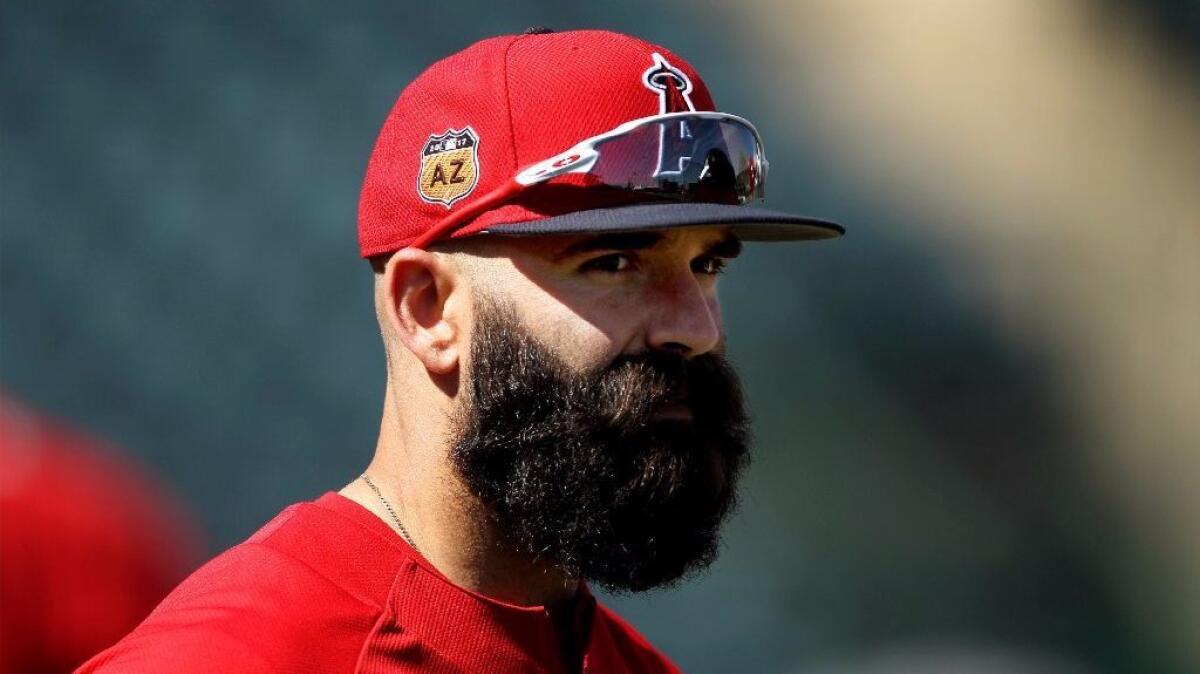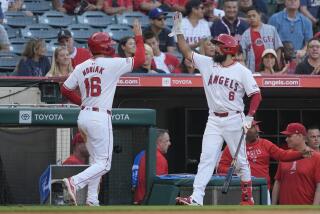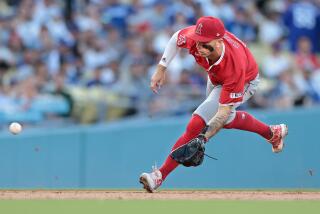New Angels second baseman Danny Espinosa has true grit: a ‘Dirtbag’ pedigree and a David Eckstein game

- Share via
Reporting from Tempe, Ariz. — The image of a revered former Angel comes to mind as Chicago Cubs Manager Joe Maddon describes new Angels second baseman Danny Espinosa, who was acquired from the Washington Nationals in December: David Eckstein, with more power and less on-base ability.
“He’s a real baseball player; he plays the game right,” Maddon said. “He’s gonna hit some home runs. You don’t expect it, but he’s got power. He works a tough at-bat. He’s gonna get hit by a lot of pitches. He’s that guy who is always in the middle of something good happening for your team, and he plays great defense.”
It’s no coincidence that Espinosa, who turns 30 in April, shares some key character traits with Eckstein, the gritty shortstop and leadoff man who played in Anaheim from 2001-2004.
Espinosa grew up a huge Angels fan and was at Santa Ana Mater Dei High when Eckstein sparked the Angels’ 2002 World Series run. Espinosa moved on to Long Beach State, where being a “Dirtbag” wasn’t just a nickname, it was a state of mind, a tough, no-nonsense, team-first approach to the game.
“I want to play hard every day for my team; I’m not gonna back down from anything,” Espinosa said. “It’s sliding hard, not to hurt someone but to disrupt a double play. It’s taking the extra base so you get into scoring position for the guy behind you.
“When I’m on first and a ball is hit into the gap, I’m going to bust it. My whole thought is to get home. It’s how I was taught to play the game, and it’s kind of stuck with me.”
Espinosa is expected to solidify a position that has vexed the Angels since Howie Kendrick was traded to the Dodgers before the 2015 season. Johnny Giavotella, the opening-day second baseman the past two seasons, provided some clutch hits in 2015 but faded badly at the plate in 2016. His defense was subpar.
In Espinosa, the Angels have a strong-armed, sure-handed defender with good range, one who committed one error in 377 chances at second in 2015 and was good enough to move to shortstop in 2016.
Paired with two-time Gold Glove-winning shortstop Andrelton Simmons, Espinosa will be part of a double-play combination that is expected to enhance the Angels’ run-prevention efforts.
“Defensively,” Angels Manager Mike Scioscia said, “you can see that Danny is going to be a difference-maker.”
Offensively, Espinosa, who is expected to bat seventh, is a switch-hitter with the power to lengthen a lineup that thinned out considerably after the fifth spot last season.
He has a career .226 average, .302 on-base percentage and .388 slugging percentage in seven seasons, all with the Nationals. He hit 20 or more homers twice, including a career-high 24 homers and 72 runs batted in last season. He was hit by 20 pitches, second-most in the National League, in 2016.
Espinosa’s glaring weakness: a career 3.77-to-1 strikeout to walk ratio, fueled by an NL-high 189 strikeouts in 2012 and 174 strikeouts in 601 plate appearances last season. On a new team that places a heavy emphasis on contact, Espinosa is making adjustments to lower that rate.
“We’ve already addressed it,” Angels hitting coach Dave Hansen said. “It’s something he wants to get better at. He knows that’s the difference, because if he already has the pop, what’s not allowing him to use the pop consistently? That’s usually discipline around the plate.”
Hansen is working with Espinosa to refine his pre-pitch movements and path through the ball and to gain a better understanding of what pitches, in what zones, he can better handle.
“He’s trimmed down some of that swing,” Hansen said. “It was a lot more violent than it is now.”
The 6-foot, 205-pound Espinosa said the key is “being on time,” getting his front foot down quickly enough for his upper half to be synchronized with his lower half.
“Being so tall [in my stance], I think I was struggling to get on time consistently,” Espinosa said. “When you’re late, you tend to over-swing to try to catch up.”
One thing the Angels won’t tinker with is Espinosa’s desire to switch-hit. The Nationals ordered Espinosa to hit only from the right side in the spring of 2015. The first time he faced a right-hander in the regular season, Espinosa turned around and doubled to right-center field off Philadelphia closer Jeanmar Gomez.
“To make that adjustment to go right on right, when you’ve never done it in the big leagues, is pretty tough,” Espinosa said. “I tried it. I wasn’t comfortable.”
A switch-hitter since Little League, Espinosa is better from the right side (career .257 average and .781 on-base-plus-slugging percentage) than the left (.216 average, .660 OPS). But his splits aren’t drastic enough to warrant scrapping his left-handed swing.
“Some kids who picked up switch-hitting later, there’s an obvious side that has a little more aggressiveness, more pop,” Hansen said. “But I couldn’t tell you which side he has more power on, and that’s a good thing.”
So was Espinosa’s trade to the Angels, and not just because his games will be so much more accessible to family members.
When Washington acquired outfielder Adam Eaton from the Chicago White Sox on Dec. 7, it pushed center fielder Trea Turner back to his natural shortstop position and Espinosa to a utility role. Three days later, Espinosa was dealt to the Angels.
“We were very happy when we found out about the trade,” said Espinosa, who is married with a 5-month-old son. “I’m excited to go home, to play at home, and to have the opportunity to play every day is awesome.”
Twitter: @MikeDiGiovanna
More to Read
Go beyond the scoreboard
Get the latest on L.A.'s teams in the daily Sports Report newsletter.
You may occasionally receive promotional content from the Los Angeles Times.







